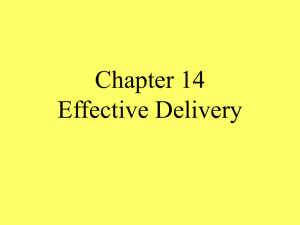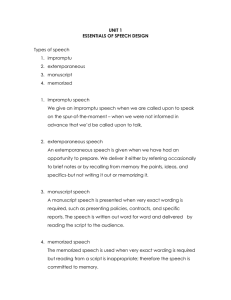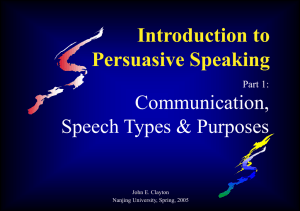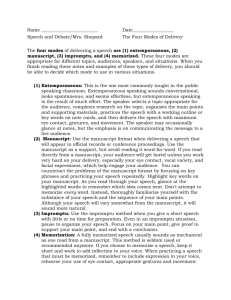Chapter 14 - Clifton High School
advertisement
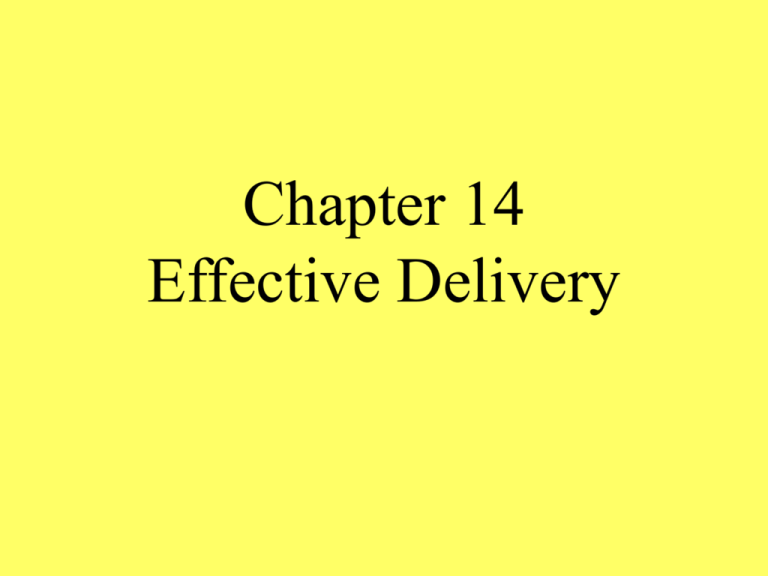
Chapter 14 Effective Delivery Types of Delivery • Your speech delivery is made up of verbal and nonverbal communication. • Studies show that how you say your words directly affects your effectiveness. • Delivery is the manner in which we speak. • #1T/F- Actual speaking increases the chances that the speaker will have impact. • #2T/F- Appearance and delivery have everything to do with a speech’s impact. • #3T/F- All speakers do not follow the same speech rules. Types of Delivery • #4IC- The four different methods of delivery are – Manuscript, where you read a speech word for word; – Memorized, repeats speech word for word; – Extemporaneous, uses a brief outline; and – Impromptu, which is totally unprepared. • #4T/F- The manuscript method decreases the chances of making an error in content. • #5T/F- The manuscript method decreases contact with your audience. • With the manuscript method, you have plenty of time to write your speech ahead of time, so it is a “security blanket.” • Since you read your speech, you have less eye contact, so your audience my feel you aren’t involved with them. Types of Delivery • In memorized delivery, you might become really tense if you realize you have forgotten a word. • You often spend more time thinking of your next words than actually bonding with the audience. • You do have the advantage with the memorized speech of planning each word, gesture, and facial expression ahead of time. • Always have a “safety valve” available in case your forget your place. • Practice saying the speech aloud in a memorized speech. • In the extemporaneous speech, the greatest advantage is that you can be natural since you can pay attention to the audience and their feedback. • Remember in the extemporaneous speech not to have too many notes. Types of Delivery • Since the impromptu method is “off the cuff”, you need a quick mind and instant audience analysis. • Since you aren’t reading, you are able to be yourself and connect to the audience. • You often have vocalized pauses (words such as “you know”, “and a”, “um”) in your impromptu speeches. • You also may appear disorganized, lacking an appropriate vocabulary, and confused. This could cause a lack of confidence. • #6T/F- You will use impromptu speaking more than any other type. • #7T/F- You may incorporate all four delivery methods into one speech. • #32B- The impromptu type of delivery, like the extemporaneous type, allows you to be yourself. Using Your Voice • • • • • • • • • A power source is the energy that makes things go. The vocal process is the power source for speakers. Phonation is voice production. #33B- The breathing system consists of the lungs, the rib cage, and all the associated muscles. #34B- The lungs are two sacks like balloons, waiting to be filled with air. #35B- The real power source for breathing is the diaphragm. #36B- Chest breathers are short of breath and weak in volume. #8T/F- Breathing from the throat produces a weak voice. #9T/F- A voice without sufficient air will not communicate well. Using Your Voice • #37B- From each lung, air travels through a tube called a bronchus. The tubes meet and form the trachea, or windpipe. The windpipe leads upward to the larynx, also known as the voice box, which is the voice-producing organ. Air move on to the pharynx, the cavity at the back of the mouth and nose, known as the oral cavity. • #5IC- The two major functions of the breathing “power system” performs for the speaker are delivering air for speaking and regulating the exact amount of air needed. Rate • Rate refers to the speed in which we speak. • #10T/F- The average rate of speaking is approximately 120-180 words per minute. • #11T/F- If you have a problem with rate, you are probably speaking too fast. • When speakers speak too fast, audiences do not have time to fully understand you fully. • It is possible to speak too slowly, but this is better than speaking too fast. • Another problem occurs with speaking very fast is that you run out of breath. • To keep from talking too fast, you should take a deep breath, give each word its due, and speak deliberately and with feeling. Pitch • Pitch refers to the highs and lows of your voice. • Monotone refers to delivering all your words methodically at almost the same rate and pitch. • #12T/F- You cannot sell a speech in a narrow vocal range. • #38B- Rate and pitch work hand in hand because you vary your speed and notes that your voice hits. • Inflection refers to the ability to alter your vocal tone or pitch to create emphasis. Volume, Pronunciation, and Articulation • • • • • • • • • • Volume refers to the loudness and softness of your voice. #13T/F- You should vary your volume depending on the situation. #14T/F- Never use falsetto, an artificially high voice. Articulation refers to the crispness with which we say our syllables. The jaw, the lips, and the tongue are known as the main articulators. Articulation problems usually occur when people who speak too fast, fail to open their mouth enough, or fail to use the tongues enough. “Mushmouth syndrome” refers to running words or syllables together. This often causes “ing” or middle “t” sounds to have problems. Pronunciation refers to saying the sounds of a word properly. #31T/F- A mispronounced word has a big impact on your speech. Two ways to improve your pronunciation include listening to intelligent people around your using the word or using the dictionary. Using Your Body • #15T/F- Your speech and your body should send the same message to the audience. • #16T/F- A good speaker, like a dancer, need a sense of rhythm. • Platform movement means walking or stepping in a purposeful manner from one spot to another while speaking. • #39B- Platform movement gives your audience a type of “eye relief.” • #17T/F- A speaker needs to worry about platform movement no matter where they are speaking, not just from a platform. • #6IC- The four “don’ts” of platform movement are don’t pace, don’t wander, don’t sneak movements, and don’t avoid movements. • #7IC- The three points to remember about how to move in a speech include moving toward the audience, knowing the number of steps you will take, and moving by leading with the leg in the direction you are going. Using Your Body • #18T/F- A good time to move in a speech is when you are going from one section of your speech to another. • #19T/F- Movement is often effective when you are changing your emotional appeal. • #20T/F- It is okay to move just because it “feels right.” • #21T/F- You should not be more concerned with planning your platform movements than with making them appear natural. • #22T/F- You should move toward the audience. Try not turn your back to them. • #23T/F- An audience member may become uncomfortable if you move too close. • #24T/F- You do need to know exactly the number of steps you will take when moving. Using Your Body • Gestures refer to the actions in which the body or parts of the body move to express an idea or emotion. • Posture refers to the body’s position when still. • Gestures should not be contrived or artificial. • #25T/F- You need to develop a sense of hand control to gesture effectively. • Your notes should be held at your waist, if you must hold them, so that they are not a distraction. • #8IC- The “do’s” and “don’ts” of good gestures include learning to use your gesture zone, learning to “lift and lay” your hands, and practicing the string idea. • #40B- The gesture zone is an imaginary box in front of you. Using Your Body • “Lifting and Laying” means you lift your arms and hands so that they move comfortably up and out, and then lay your hands at the end of a gesture as if on a table top. • Do not use the fly away, judo chop, or penguin-wave gestures. • #41B- With the fly away gesture, your hands shoot out from your sides like missiles, appearing directionless. • #42B- With the judo chop gesture, you appear to mercilessly and repeatedly hatchet your message into the minds of your audience. • #43B- With the penguin-wave gesture, you have your hands down at your sides and then flick your wrists or fingers. • #9IC- The string idea is when you pretend you have a string connecting your hands, and the string passes behind your neck. This should remind you to move your whole body, not just your arms when you gesture. • #26T/F- Taking time to watch other speakers is a good idea. Using Your Face • #27T/F- The face determines whether or not a speaker is believable. • Someone once said, “The eyes are the windows to the soul.” This is true. • 28T/F- The eyes communicate your sincerity, so you must make eye contact. • #10IC- Some points to keep in mind about good contact include looking at everyone for several seconds, looking at the far sides of the room, and looking at people, not things. • #29T/F- You should look at every person for more than a second or two. • #30T/F- You need to make eye contact with the people on the far sides of the room.
